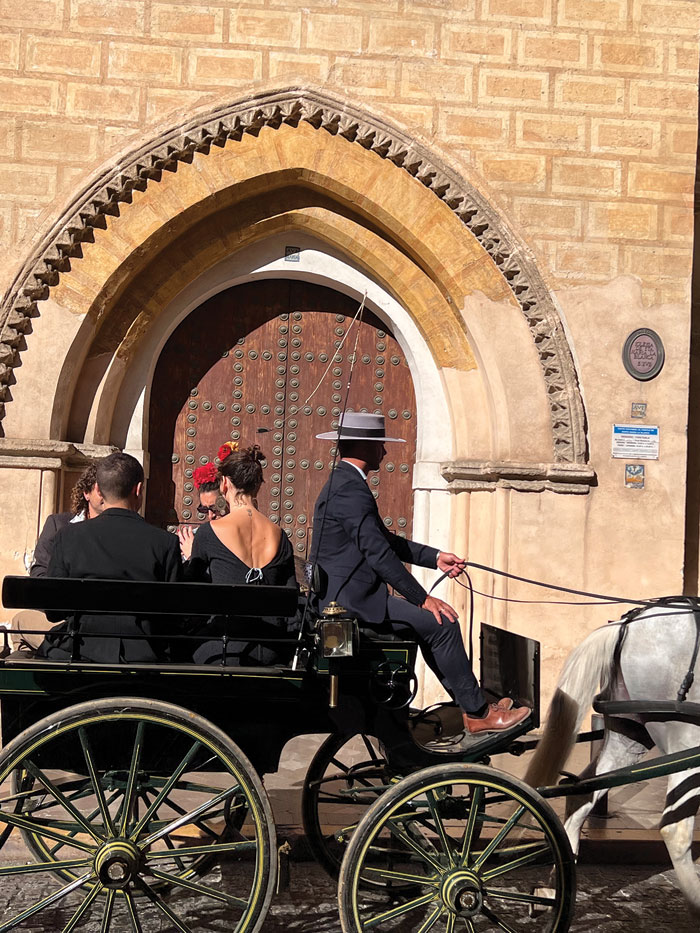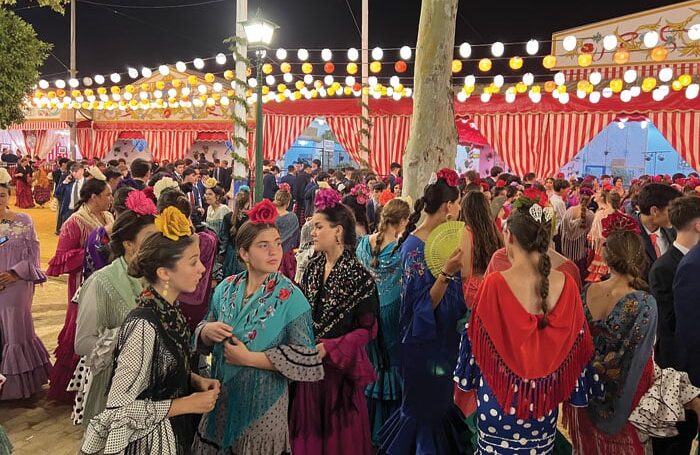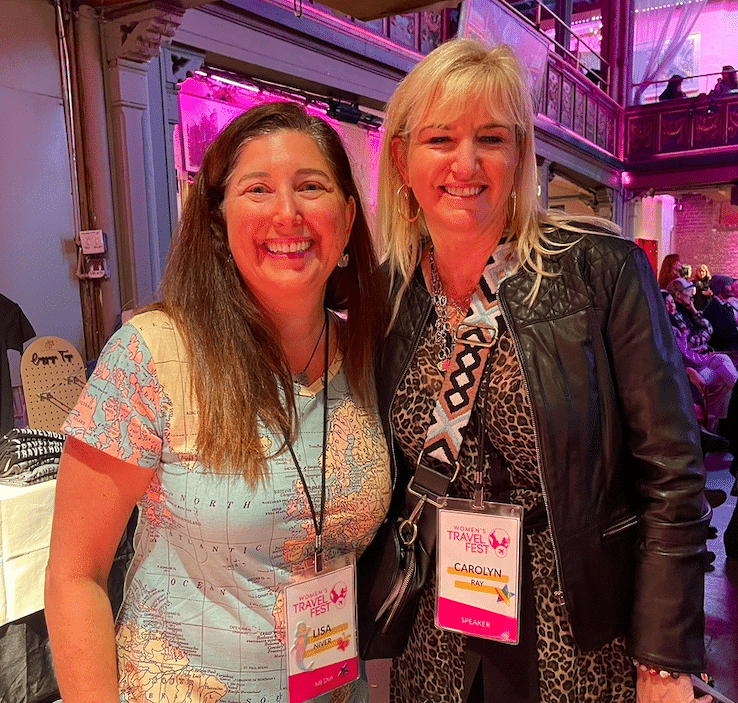
Ever since I was a little girl, my mother Rica would tell me about the beauty of Seville. When we were little, she had a funny rhyme “Quien va a Sevilla, pierde su silla!” It was an old Spanish proverb that literally means he who goes to Seville loses his seat. We always had a good laugh saying it to whoever left their chair and came back to find someone else occupying it. So in April, when Neil and I went to visit our daughter Rebekah while she was in Madrid for a semester abroad, we had to visit Seville, the capital of Andalusia.
On our train ride, we passed through the medieval towns of Andalusia, towns such as Toledo and Cordoba that once boasted thriving Jewish communities. Towns that bore witness to a Golden Age, the flowering of Jewish and Islamic literature, philosophy, culture and science in Al-Andalus. Towns that were once the home of both our ancestors for seven centuries before the Expulsion Order of 1492.
 Seville sits on the banks of the River Guadalquivir and it is indeed as breathtaking as my mother described. The Royal Alcazar is a spectacular Palace that showcases the perfect fusion of Moorish and Christian architecture, with it’s many towers, tiled chambers and gardens. The Catedral de Sevilla is one of the largest Gothic cathedrals in Europe. And the Plaza de Espana is a landmark square that features an ornate pavilion.
Seville sits on the banks of the River Guadalquivir and it is indeed as breathtaking as my mother described. The Royal Alcazar is a spectacular Palace that showcases the perfect fusion of Moorish and Christian architecture, with it’s many towers, tiled chambers and gardens. The Catedral de Sevilla is one of the largest Gothic cathedrals in Europe. And the Plaza de Espana is a landmark square that features an ornate pavilion.
Our small, charming hotel was in the old city and the narrow cobble-stoned streets (so reminiscent of the Old City of Jerusalem) made it impossible for our taxi to bring us all the way to our hotel. We started walking and were immediately entranced by the majestic orange trees that line the streets. There were still delicate white blossoms on the trees and they scented the air with their intoxicating perfume.
After dropping our (carry-on) luggage at the hotel, we ventured out in search of a cool drink. We found an establishment with a quaint courtyard, lots of tables and shady trees. We ordered two ice cold beers and perused the menu. We were excited to see foods so similar to our Sephardic recipes. Potato salad with tuna. Eggplant with honey. Our eyes lit up when we saw listed espinaca con garbanzos, spinach and garbanzo beans.
This is a famous Rhodesli dish that Neil’s mother used to cook for us. Recently, Neil had been reminiscing about his mother’s spinach and garbanzos, so I added it to my cooking repertoire. Becky, my mother-in-law, always made it with tomato sauce and lots of fresh citrusy lemon juice, but I added fresh garlic, paprika and a bit of ground coriander.
We had no idea it was a traditional Sevillan dish, one of the essential tapas. Along with the headline ingredients, this dish contains olive oil and many spices, usually garlic, cumin, ground coriander and paprika. The young server told us “this is a favorite of our abuelas (grandmothers). Everyone’s grandma makes it.” The Seville recipe calls for more spices and vinegar instead of the lemon juice my mother in law used. And their recipe also includes ground almonds and bread crumbs. Over time it has become a symbolic dish of Sevillian cuisine. It is the pride of the locals and visitors are sure to taste it when they pass through Seville. It was delicious.
There was little reminder of the Jewish community that had once walked on these same cobblestones and prayed in one of the 23 synagogues of Seville.
We had arranged a Jewish walking tour of the old city. Our excellent guide, Gershon Ovadia, a native of the Spanish Moroccan enclave of Ceuta, described how the Jewish community had once thrived in the shadow of the Alcazar Palace. He showed us a sign still identifying the Juderia, where the Jews had once lived. He showed us some of the old synagogues, now converted to churches and we could only imagine what once was. There was little reminder of the Jewish community that had once walked on these same cobblestones and prayed in one of the 23 synagogues of Seville.
 When the ancient Jewish cemetery was discovered on the outskirts of the walled city it was converted into a lovely park. Sadly, there was no Jewish organization to insist on a proper memorial to mark the sacred remnants of the Jewish community. Instead, Gershon took us to an underground parking garage. There in space number 63 in the far corner, behind a parked car, the city erected a small plaque and a window showing an ancient tombstone. It was hard to hold back the tears, imagining our ancestors that had lived here and were forced to convert or leave.
When the ancient Jewish cemetery was discovered on the outskirts of the walled city it was converted into a lovely park. Sadly, there was no Jewish organization to insist on a proper memorial to mark the sacred remnants of the Jewish community. Instead, Gershon took us to an underground parking garage. There in space number 63 in the far corner, behind a parked car, the city erected a small plaque and a window showing an ancient tombstone. It was hard to hold back the tears, imagining our ancestors that had lived here and were forced to convert or leave.
Our arrival in Seville coincided with record breaking heat and with the famous La Feria de Abril de Sevilla. The city was packed with Spaniards from all over the country attending the weeklong Seville April Fair, which began in 1846, and is the most colorful festival in all of Spain.
At midday, the fiesta begins with a parade of horse riders and carriages filled with members of the most affluent and important families in Seville. The carriages take their occupants to the bullring to watch the daily bull fights.
There are endless rows of casetas, tents owned by prominent families, businesses, political parties and clubs. Each one hosts an invitation-only party with live music, dinner and drinks. (There are also public casetas, with parties hosted by the city for those who do not get a private invitation.) There are over 1,000 tents in total, as well as many food and drink stands and fairground rides. 
Seville is the birthplace of flamenco and the majority of the women (and many men) wear their finest traditional costumes, called traje de gitana. The women are completely decked out in long ruffled dresses with fluttering sleeves and they all look beautiful with their hairstyles adorned with flowers and jeweled barrettes. All the men, young and old, wear suits and ties and some wear stylish hats.
It was all magnificent and Seville was truly magical.
—Rachel
Espinaca Con Garbanzos (Spinach and garbazo beans)
3 Tbsp extra virgin olive oil
3 cloves garlic, finely chopped
3 Tbsp tomato paste
1 tsp kosher salt
½ tsp pepper
2 tsp paprika
1 tsp ground coriander or cumin,
optional
1 15 oz can garbanzo beans, with liquid
2 lb fresh spinach
1/3 cup water
1 lemon, juiced
In a large deep pot, warm olive oil over medium heat. Add garlic, tomato paste, salt and pepper, and spices.
Sauté for 1 minute to cook the garlic and spices.
Add the garbanzo beans with their liquid and add water.
Cover and simmer for about 10 minutes, until the garbanzos have softened.
Add the spinach in batches. As the spinach cooks down, use tongs to add more and pull the cooked spinach from the bottom to cover the fresh spinach.
Repeat until all the spinach is in the pot.
Cover and simmer for 10 minutes.
Remove from heat and take off the lid. It is important to keep the spinach uncovered to prevent it from turning brown.
Pour in the lemon juice, stir gently and serve.
Note: If preparing this dish ahead of time, do not add the lemon juice until the spinach is reheated and ready to serve.
Sharon Gomperts and Rachel Emquies Sheff have been friends since high school. The Sephardic Spice Girls project has grown from their collaboration on events for the Sephardic Educational Center in Jerusalem. Follow them
on Instagram @sephardicspicegirls and on Facebook at Sephardic Spice SEC Food. Website sephardicspicegirls.com/full-recipes.





















 More news and opinions than at a Shabbat dinner, right in your inbox.
More news and opinions than at a Shabbat dinner, right in your inbox.